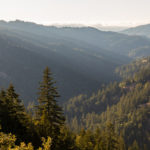
Media Contact:
Robin Carr, Landis Communications Inc.
Email: Redwoods@landispr.com | Phone: (415) 766-0927
Download the full press release
Grants include new program to support research by BIPOC students
San Francisco, Calif. (March 31, 2021) — Save the Redwoods League awarded nearly $160,000 in grant funding for 2021 research projects in California that will contribute to the growing body of knowledge about coast redwood and giant sequoia forests. Selected grantees will investigate a range of topics that include assessing impacts of wildfires in the coast redwood and giant sequoia ecosystems, exploring how giant sequoia obtain water and studying endangered California condors to inform their reintroduction to Redwood National Park.
For the first time, the League expanded its grant program offerings to also include starter grants for graduate and undergraduate students of color interested in redwoods research.
Save the Redwoods League has awarded more than $4 million in research grants since 1997 to fund studies that have provided the scientific community and the public with valuable information about coast redwood and giant sequoia forests.
“Scientific research and discovery are the cornerstone of prudent and well-informed redwood forest conservation,” said Paul Ringgold, chief program officer for Save the Redwoods League. “Equally important are the increased diversity of experience and perspectives within our scientific community that can come from our support and encouragement of graduate and undergraduate students of color—all to uncover new knowledge about California’s coast redwoods and giant sequoia and inform our conservation planning for the future.”
2021 Redwoods Research Grantees
This annual program funds research on California’s coast redwood and giant sequoia forests to help Save the Redwoods League and its conservation partners understand how to best conserve and restore targeted ecosystems. The six selected projects in 2021 are:
-
Giant Sequoia Fire and Water Project
Anthony Ambrose and Christy Brigham through the Marmot Society (South Lake Tahoe): $25,000 to investigate the water utilization of sequoia trees and how fire impacts that relationship. The study will be the first of its kind to explore where giant sequoia trees obtain water, how water sources may differ over time and across sites and how fire damage affects this process. Information from this study will help land managers implement protective measures for giant sequoia as the risks from drought, wildfires and beetles intensify.
-
Microbial Effects on Post-Fire Plant Competition in Coast Redwoods Forests
Caroline Daws and Kabir Peay from Stanford University (Palo Alto): $23,887 to research how fungi affect the growth of redwood trees and competing trees after a forest fire. The team will examine how two different types of fungi, arbuscular mycorrhizal fungi (AMF) and ectomycorrhizal fungi (EMF), grow in the wake of a fire. They will also investigate how their increased or decreased presence impacts the germination of redwood and non-redwood trees. As fires are important to the life cycle of redwood trees, this team’s efforts will help uncover how certain fungi can foster forest regeneration.
-
The Response of Redwood Mycorrhiza to Wildfires and Restoration Efforts
Kathleen Treseder and David Banuelas from UC, Irvine (Irvine): $25,000 to track the response of arbuscular mycorrhiza to road removal. This research will determine how restoration efforts to remove Sitka spruce and Douglas-fir affect coast redwood mycorrhiza in second-growth forests. Mycorrhiza, which redwood trees primarily associate with, help enhance growth for redwood seedlings. By analyzing the development of arbuscular mycorrhiza, we will be able to evaluate and predict the effects of restoration efforts.
-
Redwood Vegetation Monitoring Plots in Santa Cruz County
Julie M. Evens and Jennifer Buck-Diaz from the California Native Plant Society (Santa Cruz): $24,870 to establish ten long-term monitoring plots in redwood forest communities and train others to collect five to ten additional plots in Santa Cruz County. The plots will be placed across a gradient of hydrology and burn frequency and intensity so that different forest community types can be monitored over time. The information gathered from long-term monitoring will aid understanding of redwood forest dynamics in response to different wildfire intensities.
-
Critical Pollinators of the Redwood Forest Understory: Ecology and Conservation
Jenny Hazlehurst from CSU, East Bay (Hayward): $13,887 to observe pollinator communities in naturally recovering and actively managed second-growth redwood forests. This research project will identify pollinators that should be prioritized for monitoring and conservation efforts. It also explores the effects of clearcutting on pollinator communities. Greater understanding of these pollinators will complement the natural history of their host plants and nesting habitat to provide knowledge for restoration managers to optimize conditions for critical pollinators.
-
Characterizing Juvenile Barred Owl Dispersal in Redwood Forests with Satellite Tagging
Zach Peery from University of Wisconsin (Madison, WI): $25,000 to deploy satellite GPS tags on juvenile barred owls in Northern California. Barred owls are an invasive species that have expanded westward from the Great Plains and endanger the existence of the native northern spotted owl. Placing GPS tags on juvenile barred owls will provide insight to locating barred owl territories and how the owls disperse throughout the redwood forest ecosystem. This new information will inform land managers on how better to manage barred owls in the interest of safeguarding the redwood forest ecosystem.
Redwoods Research Starter Grants for Black, Indigenous, and People of Color
This year, Save the Redwoods League also unveiled a program of starter grants of up to $5,000 each, specifically for undergraduate and graduate students of color interested in research in the coast redwood and giant sequoia forests. The goals of this new grant category are to provide introductory opportunities to members of underrepresented communities to engage in redwoods research and to encourage a diversity of perspectives in the profession. The five selected projects are:
-
Urban Edge Effects and Forest Composition in the Coast Redwood Forest
Nanako Oba and Will Russell from San José State University (San Jose, CA): $4,662 to examine how urban edge effects influence coast redwood forest plant compositions and soil properties within the Wildland-Urban Interface in Santa Cruz Mountain forest preserves. This study will help improve the understanding of how urban development has impacted the ecology of redwood forests and inform future management decisions.
-
Condors and Redwoods Ecological Research (CARER)
José Juan Rodriguez Gutierrez and Ho Yi Wan from Humboldt State University (Arcata, CA): $5,000 to acquire knowledge about the California condor (Gymnogyps californianus). This endangered species will soon be reintroduced to northern California with support from the Yurok Tribe. They will study the condors’ movements and habitat to assist the Tribe in successfully reintroducing this keystone species to part of its historic range, which benefits the entire redwood ecosystem.
-
Changes in Bat Biodiversity from 2002-2005 to 2019-2020 in Sequoia and Kings Canyon National Parks
Natalie Yorba and Joshua Reece from California State University (Fresno, CA): $5,000 to determine potential change over time of bat species’ richness and species guilds within Sequoia and Kings Canyon National Parks. The last comparable studies were performed in 2002-2005. This new study will help determine what variables have affected bats in the years since. Seventeen species of bats are known to be present in the Sequoia and Kings Canyon National Parks. Additional research will assist land management and biodiversity conservation efforts.
-
Post-Fire Coast Redwood Response in the Santa Cruz Mountains
Tomas Velasco and Michelle Geary from West Valley College (Saratoga, CA): $2,000 to assess re-sprouting of coast redwoods damaged by the 2020 CZU Lightning Complex Fire. This study will examine the post-fire dynamics of seedling germination within coast redwood populations. It will also enhance understanding of where to prioritize the use of conservation resources, while identifying which areas may be most at risk.
-
3D Forest
Alexander Barajas-Ritchie and Lisa Patrick Bentley from Sonoma State University (Rohnert Park, CA): $5,000 to determine the volume of redwood trees from terrestrial laser scanning data via TLSeparation and OptQSM Python libraries. This study will develop an improved method for quantifying the aboveground biomass of redwood trees to determine how much carbon is stored within. The information gathered will help land managers and the general public more accurately understand how much carbon redwood forests are able to sequester for the purpose of greenhouse gas reduction.
* * *
For more information or to schedule an interview, contact Robin Carr at (415) 766-0927 or redwoods@landispr.com.
One of the nation’s longest-running conservation organizations, Save the Redwoods League has been protecting and restoring redwood forests since 1918. The League has connected generations of visitors with the beauty and serenity of the redwood forest. The nonprofit’s 26,000 supporters have enabled the organization to protect more than 216,000 acres of irreplaceable forest in 66 state, national and local parks and reserves. For information, please visit SaveTheRedwoods.org.
Tags: 2021, grants, Press Release, research, Research Grants
